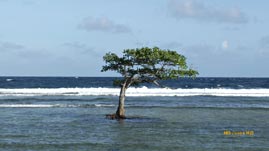Teachers' Domain - Digital Media for the Classroom and Professional Development
User: Preview

Source: Micronesia Conservation Trust
These four videos adapted from the Micronesia Conservation Trust examine environmental changes occurring in Micronesia and the steps Micronesians are taking to respond to them. In “The Problem,” fishermen discuss why things are “not right” in Micronesia; for example, fish stocks are declining and coral reefs are dying. In “The Cause,” we learn that these effects are linked to global climate change. In “The Greenhouse Effect,” we learn more about the science behind climate change. In “Adaptation,” we see how Micronesians are trying to reduce the harmful effects of climate change to preserve their homeland and secure their heritage.
Micronesia's Changing Climate: The Cause (Video)
The Greenhouse Effect Explained (Video)
Micronesia's Changing Climate: Adaptation (Video)
Vocabulary:
In the coming decades, climate change is expected to have a major impact on the Pacific Islands. Rising sea temperature, changing weather patterns, and sea level rise are some of the factors that will affect the islands’ mangroves, coral reefs, upland forests, and streams. Climate change is not the only threat. Human activities that weaken island environments can make the harmful effects of climate change even worse. These activities include pollution, land clearing, and damaging fishing and farming practices.
Pacific Islanders are already experiencing the effects of climate- and non-climate-related changes. Their income, which is earned mainly through fishing and tourism, is at risk. So is their cultural connection to the land and sea. The effects on each island will vary according to its size, its height above sea level, the scale of its reef, and the size of its freshwater lens. Even small changes can impact an island ecosystem. Just how well the ecosystem responds to changes depends on a factor called resilience.
Adaptations can increase the resilience of ecosystems. Adaptations can also benefit the human communities that depend on those ecosystems. Examples of adaptations include moving homes and roads to higher ground, reducing pollution, installing water catchments, getting rid of invasive species, and growing taro in cement patches that protect the plants from salt water. While island communities cannot remove the threat of climate change, adaptations can help reduce its harmful effects.
Micronesians are taking their first steps to adapt to climate change. Because land and water are closely connected, Micronesians are focused on keeping their forests intact, their shorelines planted, and their reefs protected. By doing so, they are giving themselves “a fighting chance” against the changes to come.
Here is a suggested way to engage students with this video and with activities related to this topic.
Class activity: Discuss the environmental changes you have seen on your island. Have students draw maps or diagrams that show the connections among ecosystems and how changes in one ecosystem can cause changes in another. For example, if a particular kind of fish is no longer found in your waters, its predators will either move elsewhere (if they can) or die off. Its prey will increase in number. Impacts on human communities can be diagrammed as well.
 Loading Standards
Loading Standards